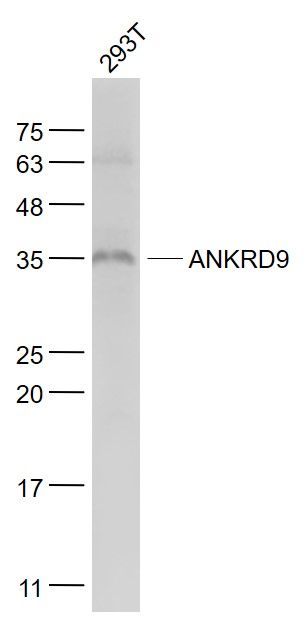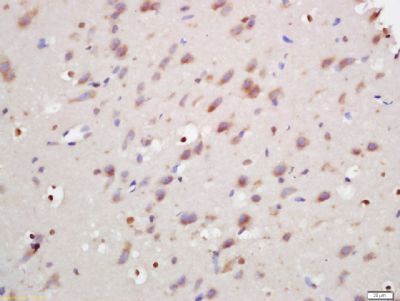ANKRD9 Polyclonal Antibody
Purified Rabbit Polyclonal Antibody (Pab)
- 产品详情
- 实验流程
Application
| WB, IHC-P, IHC-F, IF, E |
|---|---|
| Primary Accession | Q96BM1 |
| Reactivity | Rat, Pig, Dog, Bovine |
| Host | Rabbit |
| Clonality | Polyclonal |
| Calculated MW | 34295 Da |
| Physical State | Liquid |
| Immunogen | KLH conjugated synthetic peptide derived from human ANKRD9 |
| Epitope Specificity | 21-200/317 |
| Isotype | IgG |
| Purity | affinity purified by Protein A |
| Buffer | 0.01M TBS (pH7.4) with 1% BSA, 0.02% Proclin300 and 50% Glycerol. |
| SIMILARITY | Contains 3 ANK repeats. |
| Important Note | This product as supplied is intended for research use only, not for use in human, therapeutic or diagnostic applications. |
| Background Descriptions | ANKRD9 is a 317 amino acid protein that contains three ANK repeats. Encoded by a gene that maps to human chromosome 14q32.31, ANKRD9 is conserved in chimpanzee, dog, cow, mouse, rat and zebrafish. Hepatic mRNA levels of ANKRD9 are repressed by both thyroid hormone (T(3)) and fasting, and re-elevate by feeding after fasting. ANKRD9 mRNA levels also decrease in response to apoptosis. Localizing to cytoplasm, ANKRD9 may be involved in intracellular lipid accumulation and lipid metabolism. ANKRD9 may also function as a molecular chaperone |
| Gene ID | 122416 |
|---|---|
| Other Names | Ankyrin repeat domain-containing protein 9, ANKRD9 |
| Dilution | WB=1:500-2000,IHC-P=1:100-500,IHC-F=1:100-500,IF=1:100-500,ELISA=1:5000-10000 |
| Format | 0.01M TBS(pH7.4) with 1% BSA, 0.09% (W/V) sodium azide and 50% Glyce |
| Storage | Store at -20 °C for one year. Avoid repeated freeze/thaw cycles. When reconstituted in sterile pH 7.4 0.01M PBS or diluent of antibody the antibody is stable for at least two weeks at 2-4 °C. |
| Name | ANKRD9 |
|---|---|
| Function | Substrate receptor subunit of a cullin-RING superfamily E3 ligase complex (CUL5-based E3 ubiquitin ligase complex) which mediates the ubiquitination and subsequent proteasomal degradation of target proteins (PubMed:30293565). Depending of the metabolic state of the cell, promotes the proteasomal degradation of IMPDH2, the rate-limiting enzyme in GTP biosynthesis or protects IMPDH2 by stabilizing IMPDH2 filaments assembly (PubMed:30293565, PubMed:31337707). Implicated in different cellular processes, like copper homeostasis and cell proliferation (PubMed:24522796, PubMed:30293565). |
| Cellular Location | Cytoplasmic vesicle. Cytoplasm, cytosol Note=Detected in long filamentous cytosolic structures where it colocalizes with IMPDH2 (PubMed:31337707). Under basal conditions ANKRD9 is mainly in vesicle-like structures, upon nutrient limitation (guanine nucleotides deficiency) ANKRD9 loses its vesicular pattern and assembles with IMPDH2 into rodlike filaments (PubMed:31337707) |
Research Areas
For Research Use Only. Not For Use In Diagnostic Procedures.
Application Protocols
Provided below are standard protocols that you may find useful for product applications.
终于等到您。ABCEPTA(百远生物)抗体产品。
点击下方“我要评价 ”按钮提交您的反馈信息,您的反馈和评价是我们最宝贵的财富之一,
我们将在1-3个工作日内处理您的反馈信息。
如有疑问,联系:0512-88856768 tech-china@abcepta.com.
¥ 1,500.00
Cat# AP58811























 癌症的基本特征包括细胞增殖、血管生成、迁移、凋亡逃避机制和细胞永生等。找到癌症发生过程中这些通路的关键标记物和对应的抗体用于检测至关重要。
癌症的基本特征包括细胞增殖、血管生成、迁移、凋亡逃避机制和细胞永生等。找到癌症发生过程中这些通路的关键标记物和对应的抗体用于检测至关重要。 为您推荐一个泛素化位点预测神器——泛素化分析工具,可以为您的蛋白的泛素化位点作出预测和评分。
为您推荐一个泛素化位点预测神器——泛素化分析工具,可以为您的蛋白的泛素化位点作出预测和评分。 细胞自噬受体图形绘图工具为你的蛋白的细胞受体结合位点作出预测和评分,识别结合到自噬通路中的蛋白是非常重要的,便于让我们理解自噬在正常生理、病理过程中的作用,如发育、细胞分化、神经退化性疾病、压力条件下、感染和癌症。
细胞自噬受体图形绘图工具为你的蛋白的细胞受体结合位点作出预测和评分,识别结合到自噬通路中的蛋白是非常重要的,便于让我们理解自噬在正常生理、病理过程中的作用,如发育、细胞分化、神经退化性疾病、压力条件下、感染和癌症。







